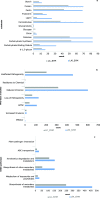Transitions of foliar mycobiota community and transcriptome in response to pathogenic conifer needle interactions
- PMID: 35551491
- PMCID: PMC9098639
- DOI: 10.1038/s41598-022-11907-0
Transitions of foliar mycobiota community and transcriptome in response to pathogenic conifer needle interactions
Abstract
Profiling the host-mycobiota interactions in healthy vs. diseased forest ecosystems helps understand the dynamics of understudied yet increasingly important threats to forest health that are emerging due to climate change. We analyzed the structural and functional changes of the mycobiota and the responses of Pinus contorta in the Lophodermella needle cast pathosystem through metabarcoding and metatranscriptomics. When needles transitioned from asymptomatic to symptomatic, dysbiosis of the mycobiota occurred, but with an enrichment of Lophodermella pathogens. Many pathogenicity-related genes were highly expressed by the mycobiota at the necrotrophic phase, showing an active pathogen response that are absent in asymptomatic needles. This study also revealed that Lophodermella spp. are members of a healthy needle mycobiota that have latent lifestyles suggesting that other pine needle pathogens may have similar biology. Interestingly, Pinus contorta upregulated defense genes in healthy needles, indicating response to fungal recognition, while a variety of biotic and abiotic stresses genes were activated in diseased needles. Further investigation to elucidate the possible antagonistic interplay of other biotic members leading to disease progression and/or suppression is warranted. This study provides insights into microbial interactions in non-model pathosystems and contributes to the development of new forest management strategies against emerging latent pathogens.
© 2022. The Author(s).
Conflict of interest statement
The authors declare no competing interests.
Figures





Similar articles
-
Development of PCR-based markers for the identification and detection of Lophodermella needle cast pathogens on Pinus contorta var. latifolia and P. flexilis.J Microbiol Methods. 2022 Sep;200:106546. doi: 10.1016/j.mimet.2022.106546. Epub 2022 Aug 2. J Microbiol Methods. 2022. PMID: 35931227
-
Comparative Gene Expression Analysis Reveals Mechanism of Pinus contorta Response to the Fungal Pathogen Dothistroma septosporum.Mol Plant Microbe Interact. 2021 Apr;34(4):397-409. doi: 10.1094/MPMI-10-20-0282-R. Epub 2021 Mar 26. Mol Plant Microbe Interact. 2021. PMID: 33258711
-
Genomic and Transcriptomic Comparisons of the Twig Blight Pathogen, Passalora sequoiae, with Mycosphaerellaceae Foliar and Conifer Pathogens.Phytopathology. 2024 Apr;114(4):732-742. doi: 10.1094/PHYTO-08-23-0271-R. Epub 2024 Mar 19. Phytopathology. 2024. PMID: 37942864
-
Profiling methyl jasmonate-responsive transcriptome for understanding induced systemic resistance in whitebark pine (Pinus albicaulis).Plant Mol Biol. 2017 Nov;95(4-5):359-374. doi: 10.1007/s11103-017-0655-z. Epub 2017 Aug 31. Plant Mol Biol. 2017. PMID: 28861810
-
Truffle species strongly shape their surrounding soil mycobiota in a Pinus armandii forest.Arch Microbiol. 2021 Dec;203(10):6303-6314. doi: 10.1007/s00203-021-02598-8. Epub 2021 Oct 15. Arch Microbiol. 2021. PMID: 34652507
Cited by
-
Foliar Fungal Endophyte Communities of Scottish Plantation Pines.J Fungi (Basel). 2025 Feb 14;11(2):148. doi: 10.3390/jof11020148. J Fungi (Basel). 2025. PMID: 39997442 Free PMC article.
References
-
- Stone JK, Polishook JD, White JF. Endophytic fungi. In: Stone JK, Polishook JD, White JF, editors. Biodiversity of Fungi. Elsevier; 2004. pp. 241–270.
-
- Terhonen E, Blumenstein K, Kovalchuk A, Asiegbu FO. Forest tree microbiomes and associated fungal endophytes: Functional roles and impact on forest health. Forests. 2019;10:42. doi: 10.3390/f10010042. - DOI
-
- Gao F, Dai C, Liu X. Mechanisms of fungal endophytes in plant protection against pathogens. Afr. J. Microbiol. Res. 2010;4:1346–1351.
-
- Sieber TN. Endophytic fungi in forest trees: Are they mutualists? Fungal Biol. Rev. 2007;21:75–89. doi: 10.1016/j.fbr.2007.05.004. - DOI
Publication types
MeSH terms
LinkOut - more resources
Full Text Sources
Miscellaneous

